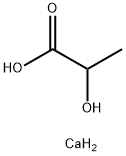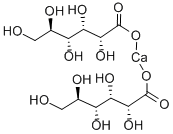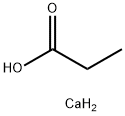Calcium lactate
Synonym(s):Calcium lactate
- CAS NO.:814-80-2
- Empirical Formula: C3H8CaO3
- Molecular Weight: 132.17
- MDL number: MFCD00150986
- EINECS: 212-406-7
- SAFETY DATA SHEET (SDS)
- Update Date: 2025-12-17 09:50:39

What is Calcium lactate?
Absorption
In order to be absorbed, calcium must be in its freely soluble form (Ca2+) or bound to a soluble organic molecule. Calcium absorption mainly occurs at the duodenum and proximal jejunum due to more acidic pH and the abundance of the calcium binding proteins . The mean calcium absorption is about 25% of calcium intake (range is 10 – 40%) in the small intestine, and is mediated by both passive diffusion and active transport .
Toxicity
The LDLo of calcium lactate pentahydrate following intravenous administration in mouse is 140 mg/kg .
Description
Calcium lactate is a black or white crystalline salt made by the action of lactic acid on calcium carbonate. It is used in foods (as an ingredient in baking powder) and given medicinally. Its E number is E327. It is created by the reaction of lactic acid with calcium carbonate or calcium hydroxide.
Calcium lactate is often found in aged cheeses. Small crystals of it precipitate out when lactic acid is converted into a less soluble form by the bacteria active during the ripening process.
In medicine, calcium lactate is most commonly used as an antacid and also to treat calcium deficiencies. Calcium lactate can be absorbed at various pHs and does not need to be taken with food for absorption for these reasons.
Calcium lactate is added to sugar-free foods to prevent tooth decay. When added to chewing gum containing xylitol, it increases the remineralization of tooth enamel.It is also added to fresh-cut fruits such as cantaloupes to keep them firm and extend their shelf life, without the bitter taste caused by calcium chloride, which can also be used for this purpose.
Chemical properties
White or almost white, crystalline or granular powder.
Chemical properties
Calcium lactate occurs as white or almost white, crystalline or granular powder. It is slightly efflorescent.
The Uses of Calcium lactate
Calcium Lactate is the calcium salt of lactic acid which is soluble in water. it has a solubility of 3.4 g/100 g of water at 20°c and is very soluble in hot water. it is available as a monohydrate, trihydrate, and pentahydrate. the trihydrate and pentahydrate have solubili- ties of 9 g in 100 ml of water at 25°c. it contains approximately 14% calcium. it is used to stabilize and improve the texture of canned fruits and vegetables by converting the labile pectin to the less solu- ble calcium pectate. it thereby prevents structural collapse during cooking. it is used in angel food cake, whipped toppings, and meringues to increase protein extensibility which results in an increase of foam volume. it is also used in calcium fortified foods such as infant foods and is used to improve the properties of dry milk powder.
The Uses of Calcium lactate
As a preservative in foods and beverages; in dentifrices.
The Uses of Calcium lactate
Lactic Acid Calcium Salt is used in foods as an ingredient in baking powder. Lactic Acid Calcium Salt is also used as an antacid and also to treat calcium deficiencies.
Indications
Indicated for use as the nutritional supplement.
Background
Calcium lactate is a salt that consists of two lactate anions for each calcium cation (Ca2+). It is prepared commercially by the neutralization of lactic acid with calcium carbonate or calcium hydroxide. Approved by the FDA as a direct food substance affirmed as generally recognized as safe, calcium lactate is used as a firming agent, flavoring agent, leavening agent, stabilizer, and thickener . Calcium lactate is also found in daily dietary supplements as a source of calcium. It is also available in various hydrate forms, where calcium lactate pentahydrate is the most common.
Production Methods
Calcium lactate is prepared commercially by neutralization with calcium carbonate or calcium hydroxide of lactic acid obtained from fermentation of dextrose, molasses, starch, sugar, or whey.
brand name
Prequist Powder (Parke-Davis).
Hazard
A poison.
Pharmaceutical Applications
Calcium lactate is used as a bioavailability enhancer and nutrient
supplement in pharmaceutical formulations.
A spray-dried grade of calcium lactate pentahydrate has been
used as a tablet diluent in direct compression systems, and has
been shown to have good compactability. The properties of the
pentahydrate form have been considered superior to those of
calcium lactate trihydrate when used in direct compression tablet
formulations. Tablet properties may be affected by the hydration
state of the calcium lactate and particle size of the material: reducing
particle size increased crushing strength, whereas storage of tablets
at elevated temperature resulted in dehydration accompanied by a
reduction in crushing strength.
Calcium lactate has also been used as the source of calcium ions
in the preparation of calcium alginate microspheres for controlled-
release delivery of active agents. It has been shown to result in lower
calcium concentrations in the finished microspheres when compared
with calcium acetate.
Therapeutically, calcium lactate has been used in preparations
for the treatment of calcium deficiency.
Pharmacokinetics
Both components of calcium lactate, calcium ion and lactic acid, play essential roles in the human body as a skeletal element an energy source, respectively .
Safety
Calcium lactate was found to have no toxic or carcinogenic effects when dosed at levels of 0%, 2.5%, and 5% in drinking water to male and female rats for 2 years.
Metabolism
In hepatic gluconeogenesis, lactic acid is converted to glucose. Lactic acid may be further catabolyzed in the lactic acid cycle .
Storage
Calcium lactate can exist in a number of hydration states, which are characterized as anhydrous, monohydrate, trihydrate, and pentahydrate. Dehydration of the pentahydrate form is rapid at temperatures of 558℃ and above. Dehydration is reported to be accompanied by some loss of crystallinity. Tablet crushing strength was reported to be reduced following dehydration of calcium lactate pentahydrate.
Purification Methods
Crystallise it from warm water (10mL/g) by cooling to 0o. [Beilstein 3 IV 636.]
Incompatibilities
Calcium salts, including the lactate, can display physical incompatibility with phosphate in the diet or therapeutic preparations, for example in enteral feed mixtures.
Regulatory Status
GRAS listed except for infant foods/formulas. Accepted as a food additive in Europe. Calcium lactate (anhydrous) is included in the FDA Inactive Ingredients Database (vaginal, tablet). It is used in oral dosage forms. Included in vaginal pessary formulations licensed in the UK.
Properties of Calcium lactate
| solubility | Soluble in water, freely soluble in boiling water, very slightly soluble in ethanol (96 per cent). |
| PH | 7.56(1 mM solution);7.97(10 mM solution);8.28(100 mM solution);8.5(1000 mM solution) |
| Odor | Odorless |
| CAS DataBase Reference | 814-80-2(CAS DataBase Reference) |
| EPA Substance Registry System | Calcium lactate (814-80-2) |
Safety information for Calcium lactate
Computed Descriptors for Calcium lactate
Calcium lactate manufacturer
Vasa Pharmachem Pvt Ltd. (VPPL)
New Products
4,4-Difluoropiperidine hydrochloride tert-butyl 9-methoxy-3-azaspiro[5.5]undecane-3-carboxylate Indole Methyl Resin N-Isopropylurea N,N-Dicyclohexylcarbodiimide(DCC) MELDRUMS ACID 5-METHYLISOXAZOLE-4-CARBOXYLIC ACID Magnessium Bis glycinate Zinc ascorbate 1-bromo-2-butyne 2-acetamidophenol 9(10H)-anthracenone Erythrosin B, 4-Piperidinopiperidine 2-((4-morpholinophenylamino) (methylthio) methylene) malononitrile 2,4-dihydroxybenzaldehyde 3-(4-morpholinophenylamino)-5-amino-1H-pyrazole-4-carbonitrile Methyl 2-methylquinoline-6-carboxylate 2,6-dichloro-4-nitropyridine 4-Bromo-2-chlorobenzonitrile 2-(benzylamino)acetic acid hydrochloride 4-(tert-Butoxycarbonylamino)but- 2-ynoic acid 3,4-dihydro-2H-benzo[b][1,4]dioxepine 1-Phenyl-1-cycloprppanecarboxylicacidRelated products of tetrahydrofuran








You may like
-
 CALCIUM LACTATE 99%View Details
CALCIUM LACTATE 99%View Details -
 Calcium lactate 98%View Details
Calcium lactate 98%View Details -
 Calcium lactate 814-80-2 99%View Details
Calcium lactate 814-80-2 99%View Details
814-80-2 -
 814-80-2 99%View Details
814-80-2 99%View Details
814-80-2 -
 Calcium lactate 99%View Details
Calcium lactate 99%View Details
814-80-2 -
 Calcium lactate 98%View Details
Calcium lactate 98%View Details
814-80-2 -
 Calcium lactate 814-80-2 99%View Details
Calcium lactate 814-80-2 99%View Details
814-80-2 -
 Calcium lactate 95% CAS 814-80-2View Details
Calcium lactate 95% CAS 814-80-2View Details
814-80-2
